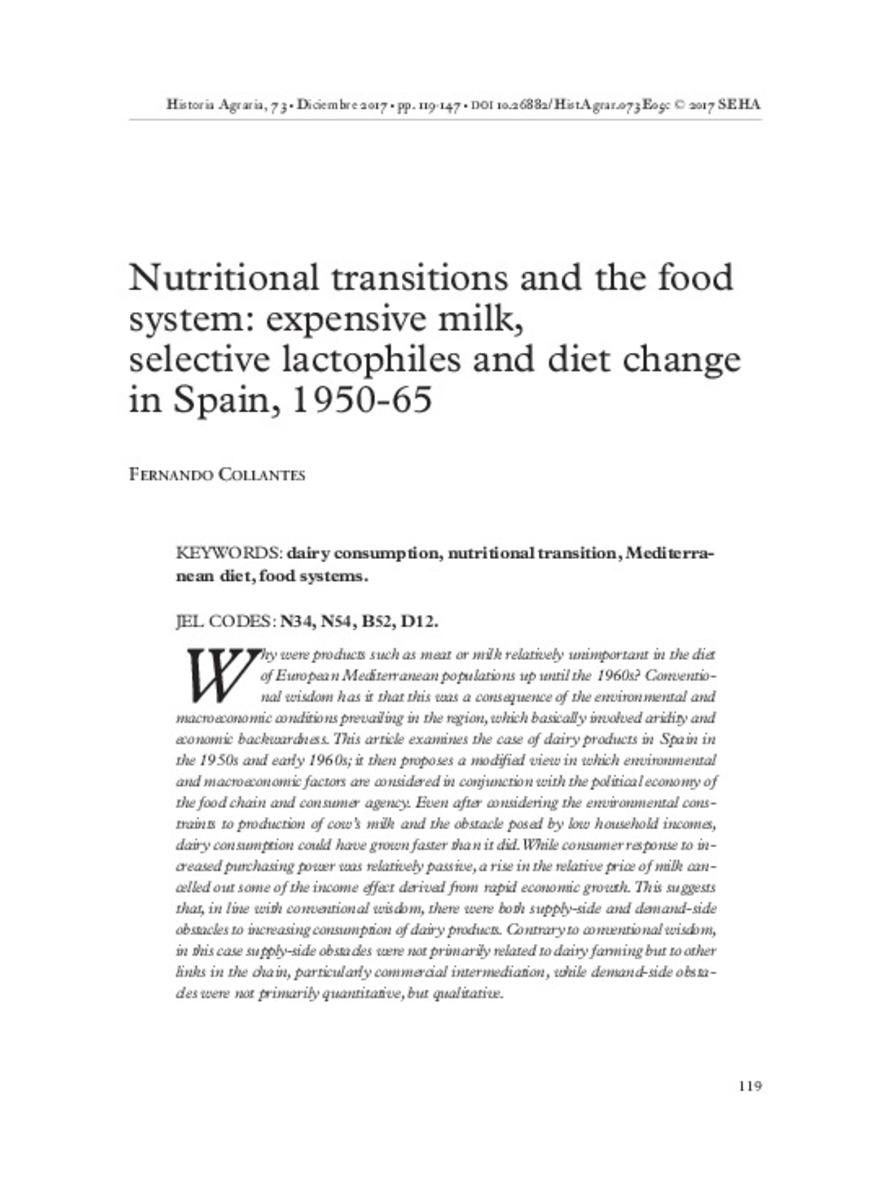Mostrar el registro sencillo del ítem
Nutritional transitions and the food system: expensive milk, selective lactophiles and diet change in Spain, 1950-65
| dc.contributor.author | Collantes, Fernando | |
| dc.date.accessioned | 2018-03-04T17:29:54Z | |
| dc.date.available | 2018-03-04T17:29:54Z | |
| dc.date.issued | 2017-12 | |
| dc.identifier.issn | 1139-1472 | |
| dc.identifier.uri | http://hdl.handle.net/10234/173191 | |
| dc.description.abstract | Why were products such as meat or milk relatively unimportant in the diet of European Mediterranean populations up until the 1960s? Conventional wisdom has it that this was a consequence of the environmental and macroeconomic conditions prevailing in the region, which basically involved aridity and economic backwardness. This article examines the case of dairy products in Spain in the 1950s and early 1960s; it then proposes a modified view in which environmental and macroeconomic factors are considered in conjunction with the political economy of the food chain and consumer agency. Even after considering the environmental constraints to production of cow’s milk and the obstacle posed by low household incomes, dairy consumption could have grown faster than it did. While consumer response to increased purchasing power was relatively passive, a rise in the relative price of milk cancelled out some of the income effect derived from rapid economic growth. This suggests that, in line with conventional wisdom, there were both supply-side and demand-side obstacles to increasing consumption of dairy products. Contrary to conventional wisdom, in this case supply-side obstacles were not primarily related to dairy farming but to other links in the chain, particularly commercial intermediation, while demand-side obstacles were not primarily quantitative, but qualitative. | ca_CA |
| dc.description.abstract | En el siguiente texto estudiaremos la conflictividad que protagonizaron las comunidades mapuches de la provincia de Cautín durante el período de la reforma agraria en Chile. Para ello, analizaremos, tanto documentación periodística (esencialmente el principal periódico regional, El Diario Austral) como documentación archivística de origen gubernamental. Para contextualizar la investigación, comenzaremos por repasar los antecedentes históricos del conflicto mapuche, y el contexto general de la cuestión agraria y mapuche en Chile durante el período a analizar. Posteriormente, nos centraremos en el análisis de los conflictos indígenas en Cautín, los cuales tuvieron como especial expresión de protesta las tomas de fundos. Todo ello nos permitirá ver, en primer lugar, que éstos fueron los conflictos indígenas más importantes y generalizados desde la ocupación militar de la Araucanía; en segundo lugar, que las tomas de fundos consiguieron su principal objetivo, esto es, acelerar el proceso expropiatorio a favor de comunidades mapuches; y, por último, desmentir algunos tópicos sobre las tomas y la participación de los mapuches que han pervivido hasta nuestros días. | ca_CA |
| dc.format.extent | 29 p. | ca_CA |
| dc.format.mimetype | application/pdf | ca_CA |
| dc.language.iso | eng | ca_CA |
| dc.publisher | Sociedad Española de Historia Agraria (SEHA) | ca_CA |
| dc.relation.isPartOf | Historia agraria: Revista de agricultura e historia rural, nº 73, 119-147 | ca_CA |
| dc.rights | © 2017 SEHA | ca_CA |
| dc.rights | Attribution-NonCommercial-NoDerivatives 4.0 Internacional | * |
| dc.rights.uri | http://creativecommons.org/licenses/by-nc-nd/4.0/ | * |
| dc.subject | consumo de productos lácteos | ca_CA |
| dc.subject | cadena alimentaria | ca_CA |
| dc.subject | dieta mediterránea | ca_CA |
| dc.subject | sistemas alimentarios | ca_CA |
| dc.subject | dairy consumption | ca_CA |
| dc.subject | nutritional transition | ca_CA |
| dc.subject | food systems | ca_CA |
| dc.subject | Mediterranean diet | ca_CA |
| dc.title | Nutritional transitions and the food system: expensive milk, selective lactophiles and diet change in Spain, 1950-65 | ca_CA |
| dc.type | info:eu-repo/semantics/article | ca_CA |
| dc.subject.jel | N34 | ca_CA |
| dc.subject.jel | N54 | ca_CA |
| dc.subject.jel | B52 | ca_CA |
| dc.subject.jel | D12 | ca_CA |
| dc.identifier.doi | http://dx.doi.org/10.26882/HistAgrar.073E05c | |
| dc.rights.accessRights | info:eu-repo/semantics/openAccess | ca_CA |
| dc.relation.publisherVersion | http://www.historiaagraria.com/numero.php?n=73 | ca_CA |








